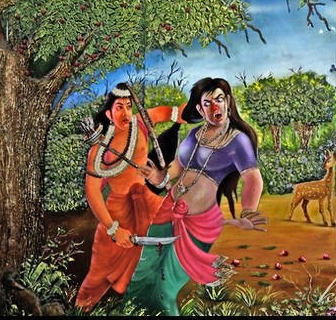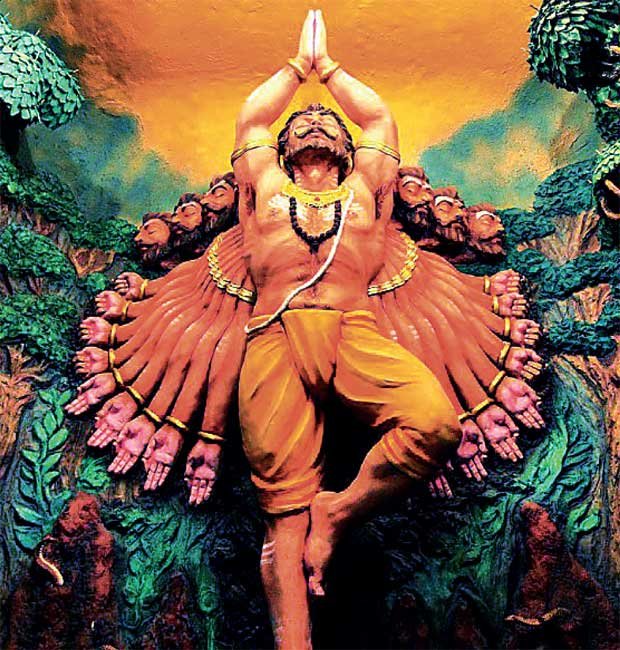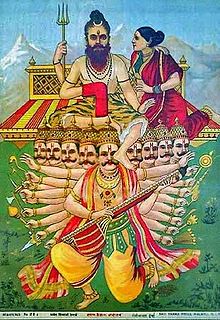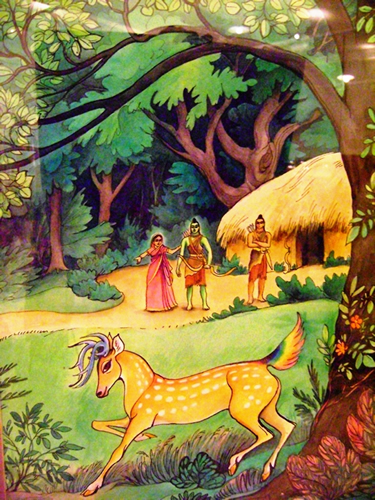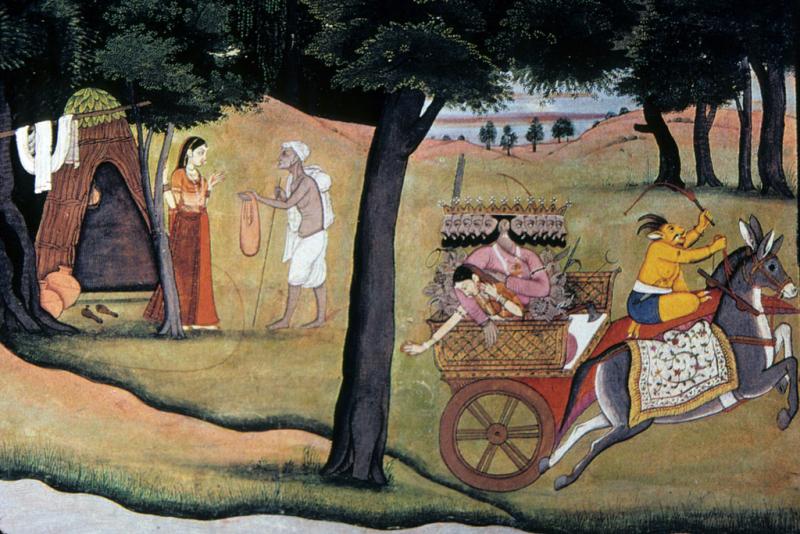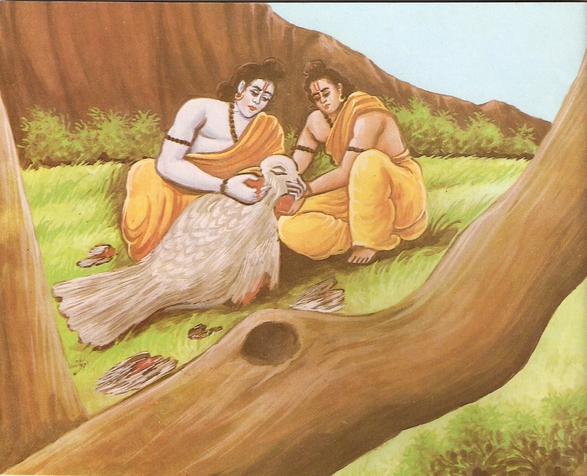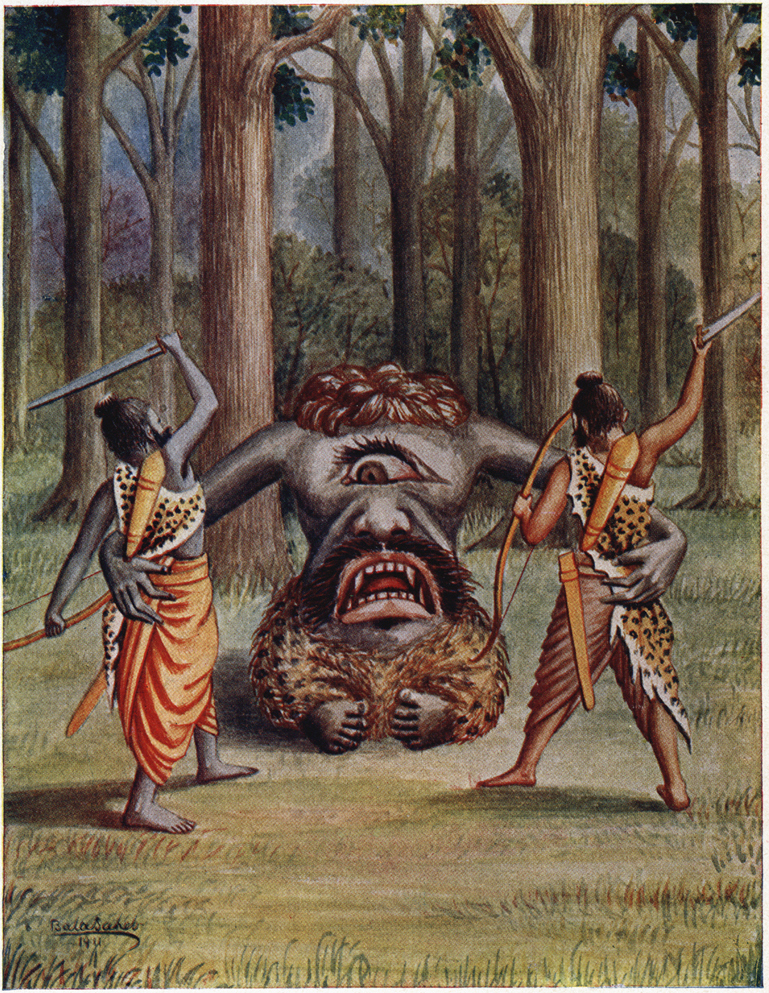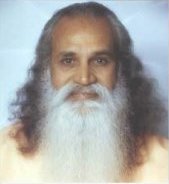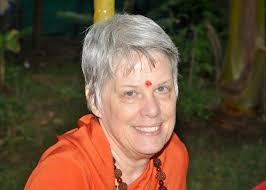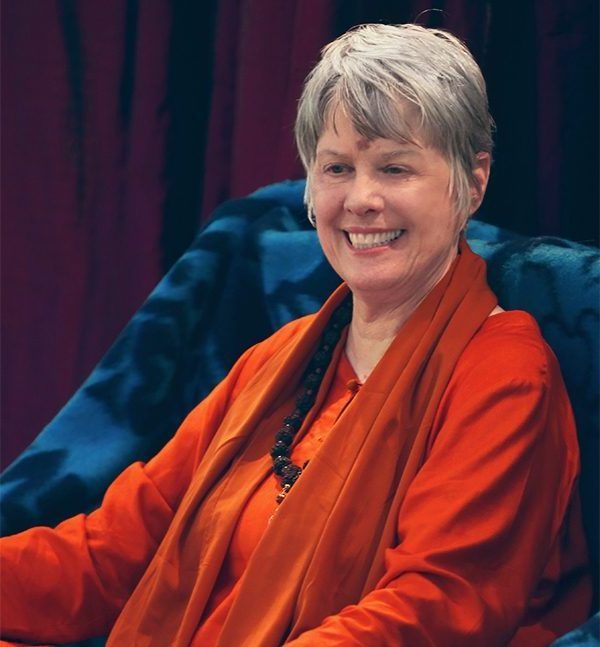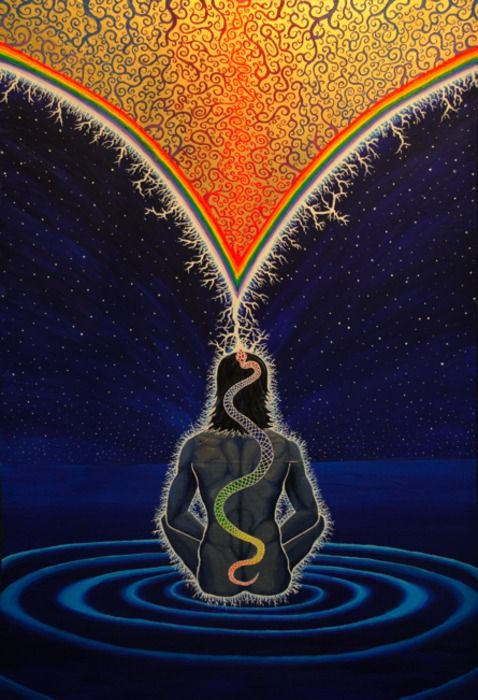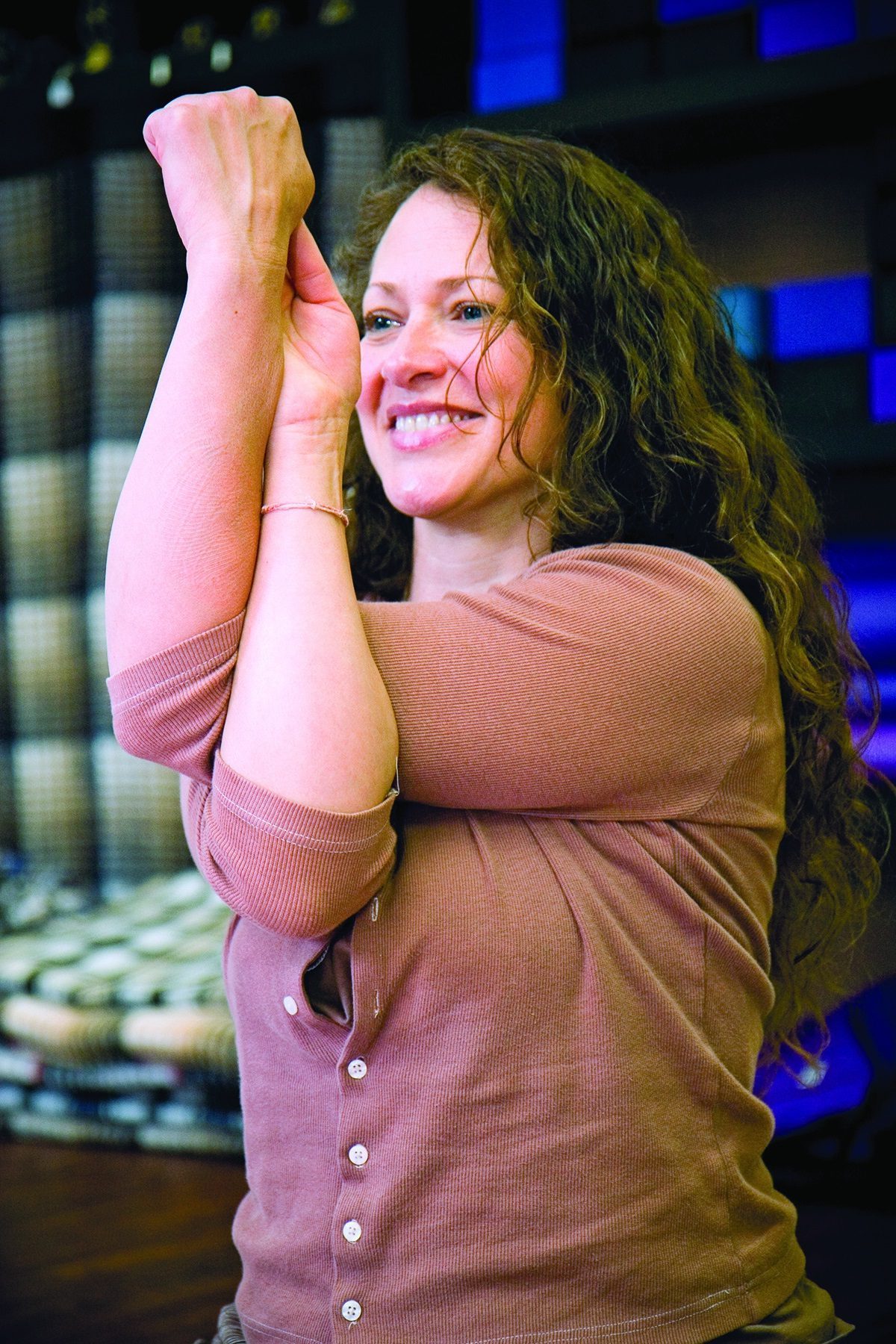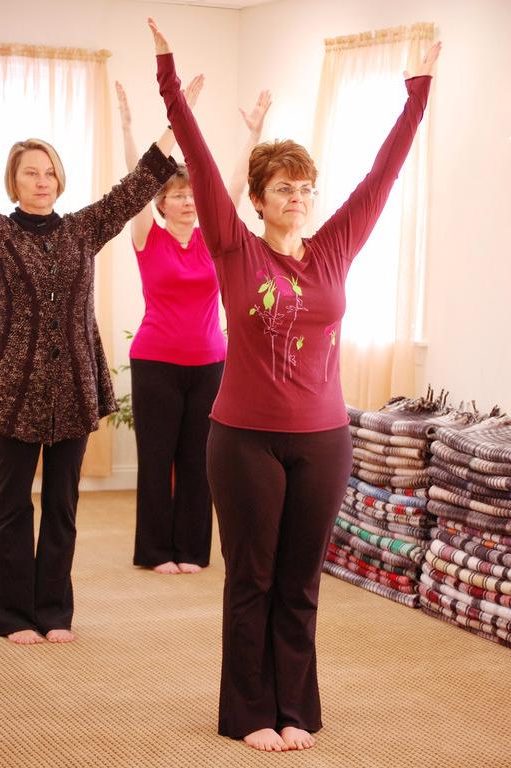Sita had been kidnapped. Searching for her, Rama and Lakshmana came across a great strong monkey, who introduced himself as Hanuman.
Who is Hanuman?
Many stories are told about the great ones! So it is with Hanuman. One story tells that Hanuman was the incarnation of Lord Shiva, coming to help Lord Vishnu in his Rama avatar.
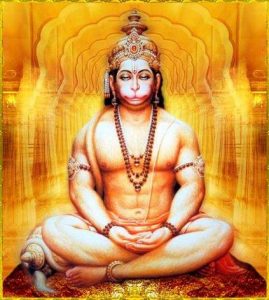 Hanuman is also called the son of Vayu, the Wind God. This is what gave him the ability to fly and to take on different forms. Hanuman was born to Anjana and Kesari. Anjana had prayed diligently to Lord Shiva, asking him to take birth as her son. Thus the great and mighty Hanuman came into being.
Hanuman is also called the son of Vayu, the Wind God. This is what gave him the ability to fly and to take on different forms. Hanuman was born to Anjana and Kesari. Anjana had prayed diligently to Lord Shiva, asking him to take birth as her son. Thus the great and mighty Hanuman came into being.
The mischievous Hanuman, when he was young, swallowed the sun, which he released only after the Devas had prayed to him. Hanuman began using his supernatural powers in a mischievous way. One day he pranked a meditating sage. In a fury, the sage cursed Hanuman to forget his powers temporarily. Later, when he became an adult, the curse lifted and Hanuman remembered all of his godlike powers.
When Rama found him, Hanuman was living near Mount Rishyamukha with Sugreeva. Sugreeva was hiding from his brother Vali, the king of the vanaras (monkeys). Seeing Rama & Lakshmana, Sugreeva misunderstood them to be allies of his brother, coming to harm him. Sugreeva sent Hanuman, his friend and minister to go find out about them.
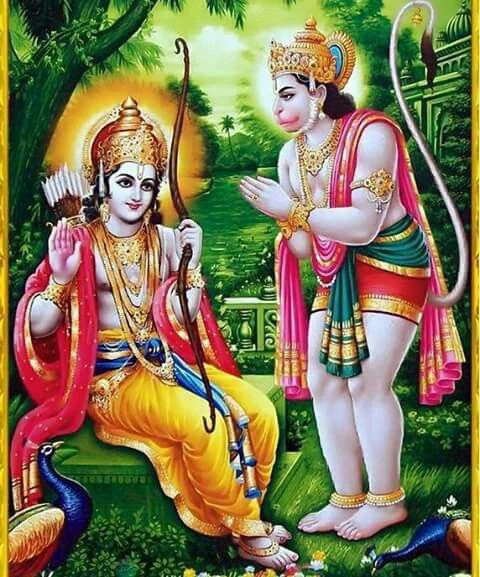 Hanuman introduced himself to Rama and Lakshmana who shared their devastating story with Hanuman. Hearing this, Hanuman’s heart was filled with love, respect and devotion towards Rama. After he listened to the story of the kidnapping, Hanuman told about Sugreeva, who was in a similar predicament, being in exile in the forest.
Hanuman introduced himself to Rama and Lakshmana who shared their devastating story with Hanuman. Hearing this, Hanuman’s heart was filled with love, respect and devotion towards Rama. After he listened to the story of the kidnapping, Hanuman told about Sugreeva, who was in a similar predicament, being in exile in the forest.
Vali and Sugreeva were very close and loving brothers. Vali was king of Kishkindha, the vanara kingdom; Tara was his wife. A demon named Maayaavi came to Kishkindha, challenging Vali for a fight. Vali accepted, but Maayaavi ran into the jungle and inside his deep cave so he could have the upper hand. The brothers followed him through the jungle. Though Sugreeva tried to stop Vali, Vali entered the cave, telling Sugreeva to wait outside. Many days went by but Vali didn’t return. Sugreeva didn’t leave his post.
Suddenly one day Sugreeva heard Maayaavi’s roar. Then a stream of blood gushed out of the cave, followed by another roar. Sugreeva thought it was Maayaavi’s cry of triumph and that Vali had been killed. Sugreeva thought for a while and decided to block the entrance of the cave with a huge boulder, in order to stop Maayaavi from coming out and attacking Kishkindha. He returned home with a heavy heart, not talking to anyone for days.
However, inside the cave, Vali had killed Maayaavi. Eagerly coming out to see Sugreeva, Vali found the entrance blocked by a boulder. He thought that Sugreeva betrayed him for the throne. There was no way out of the cave but Vali continued trying to push the boulder aside.
Back in the kingdom, Sugreeva continued to be silent. Hanuman was one of the nobles at the court as well as a dear friend. He approached Sugreeva, insisting that the throne must not remain vacant. As Vali’s brother, Sugreeva should take Vali’s place. With great hesitation, and after a lot of thought, Sugreeva agreed. He ascended the throne for the sake of his people. Hanuman served him well as his minister.
Time passed. One day, Vali succeeded in pushing the boulder a little so he could scrape through a small opening. He arrived at the palace a few days later. While Sugreeva was delighted to see his beloved brother alive, Vali was not in a mood for loving reunions. He furiously accused his brother of being a hypocrite who trapped him in the cave. He was not willing to listen to Sugreeva or anyone.
Vali banished Sugreeva from Kishkindha. When Sugreeva’s wife, Ruma, attempted to go with him, Vali claimed her to be his property and would not let her go. Hanuman somehow managed to join Sugreeva and both of them left Kishkindha. They reached the Rishyamukha Mountains, where Sugreeva was safe, since Vali could not go there due to a curse from Rishi Matanga.
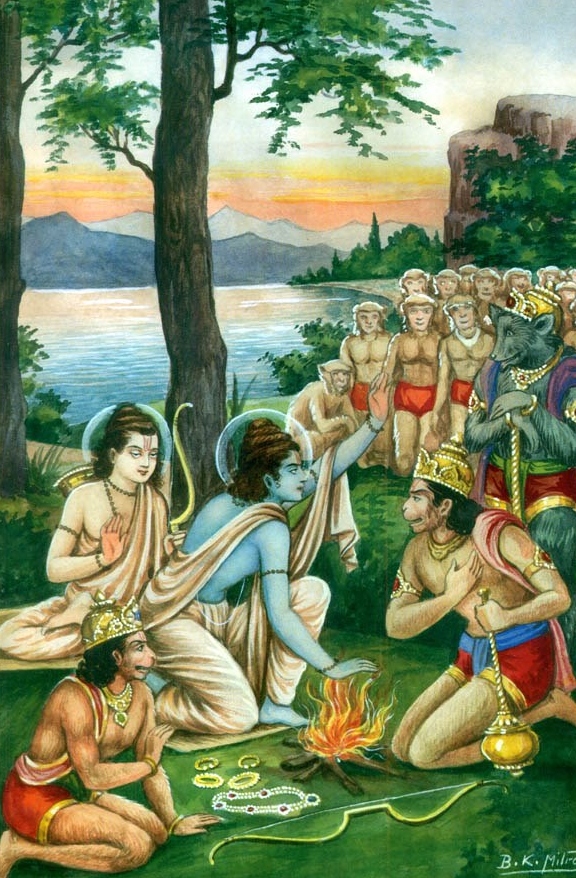 Hanuman finished Sugreeva’s story. He thought Rama and Lakshmana would be able to help Sugreeva free his wife, so he invited them to meet Sugreeva. They accepted the invitation, so Hanuman took his gargantuan form, picked up Rama and Lakshmana and flew through the woods to Sugreeva’s hiding place. There, Rama promised to help Sugreeva to retrieve his wife, Ruma. In return, Sugreeva promised to help Rama find Sita and help him in every way.
Hanuman finished Sugreeva’s story. He thought Rama and Lakshmana would be able to help Sugreeva free his wife, so he invited them to meet Sugreeva. They accepted the invitation, so Hanuman took his gargantuan form, picked up Rama and Lakshmana and flew through the woods to Sugreeva’s hiding place. There, Rama promised to help Sugreeva to retrieve his wife, Ruma. In return, Sugreeva promised to help Rama find Sita and help him in every way.
In a duel, Vali gained half his opponent’s strength, thus no one was able to beat Vali in direct combat. Knowing his brother’s strength, Sugreeva doubted that Rama could win. After a few tests, which Rama passed with ease, Sugreeva started to believe in Rama. Hanuman became an ardent admirer of Rama, very loyal to him, not letting Rama out of his sight.
They decided it was time to free Ruma. The plan was for Sugreeva to challenge Vali, then Rama was to kill Vali while he and Sugreeva were in combat. Sugreeva went to Kishkindha, followed by Rama. As planned, Sugreeva challenged his brother. The duel was fierce. Rama was unable to get a clear shot at Vali because both brothers looked very much the same.
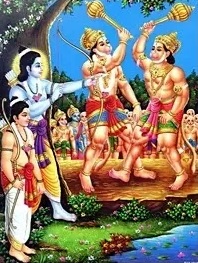 Unable to defeat Vali, Sugreeva retreated to Rishyamukha Mountains. They decided that Sugreeva would wear a garland so that Rama could identify Vali. Through some spies, Vali’s wife Tara found out that Sugreeva had the support of a prince from the North. She tried to stop Vali from going to the duel when Sugreeva challenged him again. Vali disregarded his wife and went to the fight. This time, though Vali had the upper hand, Rama was able to distinguish Vali from Sugreeva, and kill him with his arrow, shot from behind a tree.
Unable to defeat Vali, Sugreeva retreated to Rishyamukha Mountains. They decided that Sugreeva would wear a garland so that Rama could identify Vali. Through some spies, Vali’s wife Tara found out that Sugreeva had the support of a prince from the North. She tried to stop Vali from going to the duel when Sugreeva challenged him again. Vali disregarded his wife and went to the fight. This time, though Vali had the upper hand, Rama was able to distinguish Vali from Sugreeva, and kill him with his arrow, shot from behind a tree.
With his last few breaths, Vali asked Rama to defend his action of killing someone who was not in combat with him. Rama explained that it is the duty of a king to uphold justice, and that Vali should have listened to his brother without prior judgment and treated him as his son. Rama also pointed out his worst mistake of keeping Ruma, Sugreeva’s wife with him. Because Vali had wronged Sugreeva, Rama had done justice.
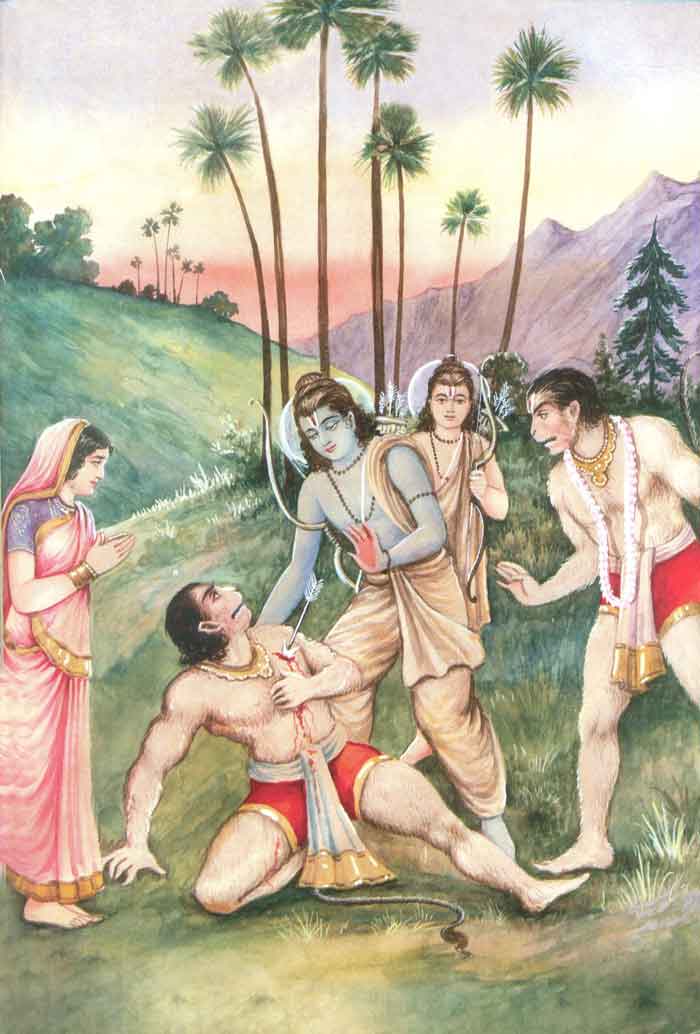 Vali was full of remorse when he heard Rama’s words, and requested Sugreeva and Rama both to pardon his actions. He also requested them not to vest his sins on his wife and his son Angada, but to look after them. With a heavy heart, Sugreeva told his brother that all he had wanted from him was his love and nothing more. Vali blessed Sugreeva and died.
Vali was full of remorse when he heard Rama’s words, and requested Sugreeva and Rama both to pardon his actions. He also requested them not to vest his sins on his wife and his son Angada, but to look after them. With a heavy heart, Sugreeva told his brother that all he had wanted from him was his love and nothing more. Vali blessed Sugreeva and died.
After doing the last rites for his brother, Sugreeva ascended the throne. He crowned Vali’s son Angada as the crown prince. However, Sugreeva soon forgot his promise to Rama, spending his time in enjoying his regained status. The clever former ape queen Tara and Hanuman calmly intervened to prevent an enraged Lakshmana from destroying the ape citadel. They made Sugreeva understand his duty and honor his pledge.
Sugreeva then sent search parties in all four directions, but they returned without success from the north, east and west. Under the leadership of Angada and Hanuman, the southern search party reached the southern tip of the great land and sat on the south shore, depressed. Angada said, “We have tried our best, but we have failed miserably. I, as the leader of the party, am not prepared to go back to Kishkindha empty handed. In fact I would like to kill myself here and equal myself to Jatayu the king of eagles who had sacrificed his life in service to Rama.”
Everyone in the search party was talking about the failed end of their search, when someone called to them from behind, “Friends!” Everyone turned to see an eagle slowly walking towards them. The eagle said, “Friends, I heard my brother Jatayu’s name come up in your conversation. May I know how you came to know of my Jatayu?” Angada told the eagle about Sita’s kidnapping.
The bird continued, “My name is Sampaathi. We eagles are bestowed with very keen eyesight. We are capable of pinpointing things at great distance. I have seen Sita in a grove in Lankapuri.” Uttering these words, Sampaathi, flew away.
Hearing this, Hanuman without wasting a second, took on his gargantuan form and made a colossal leap across the sea to Lankapuri.
More to come…

